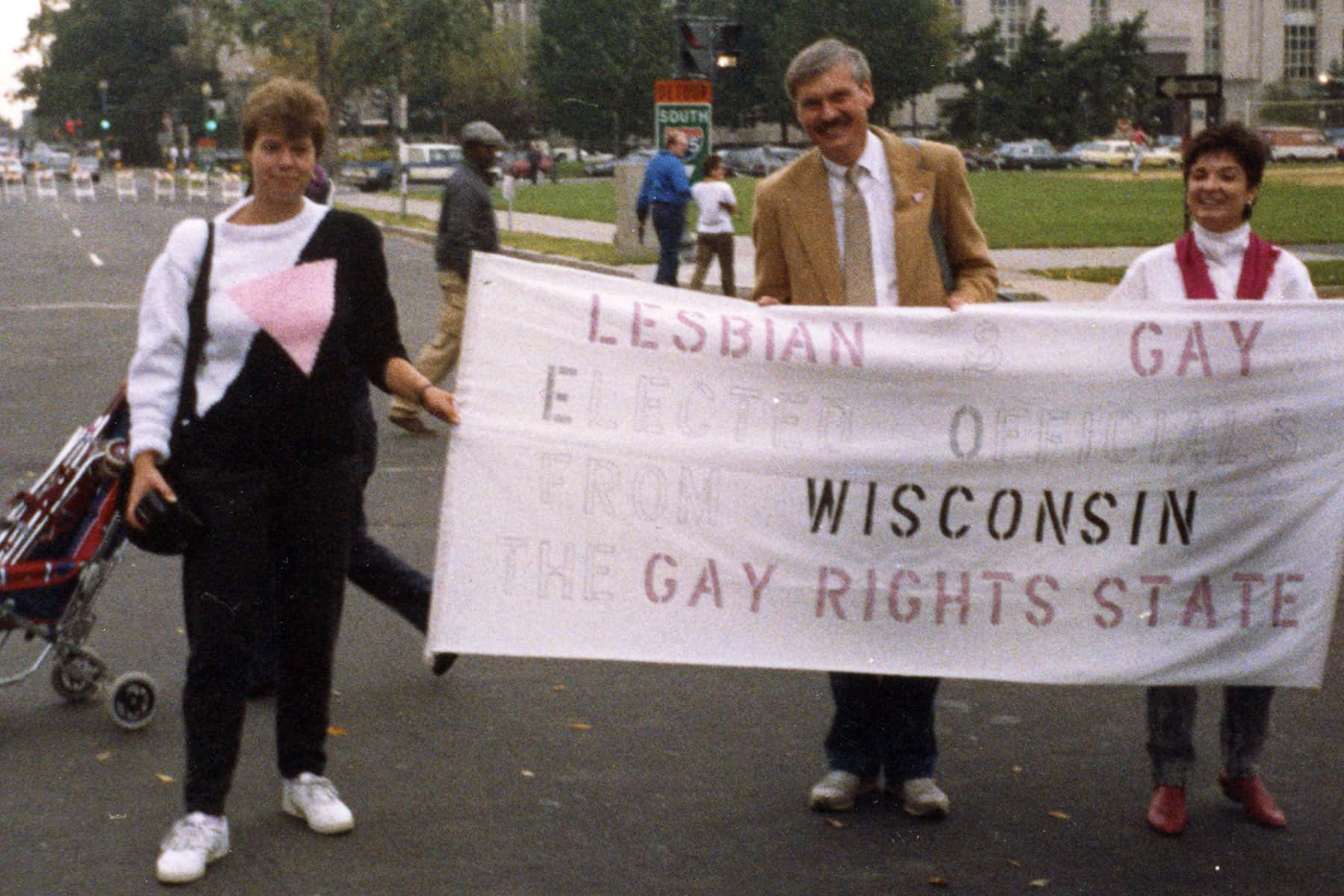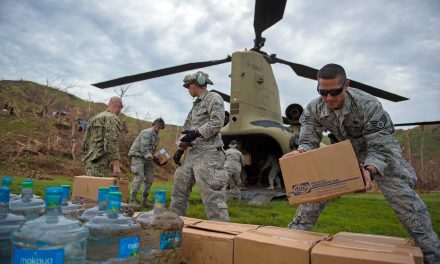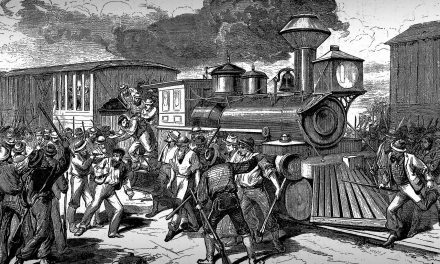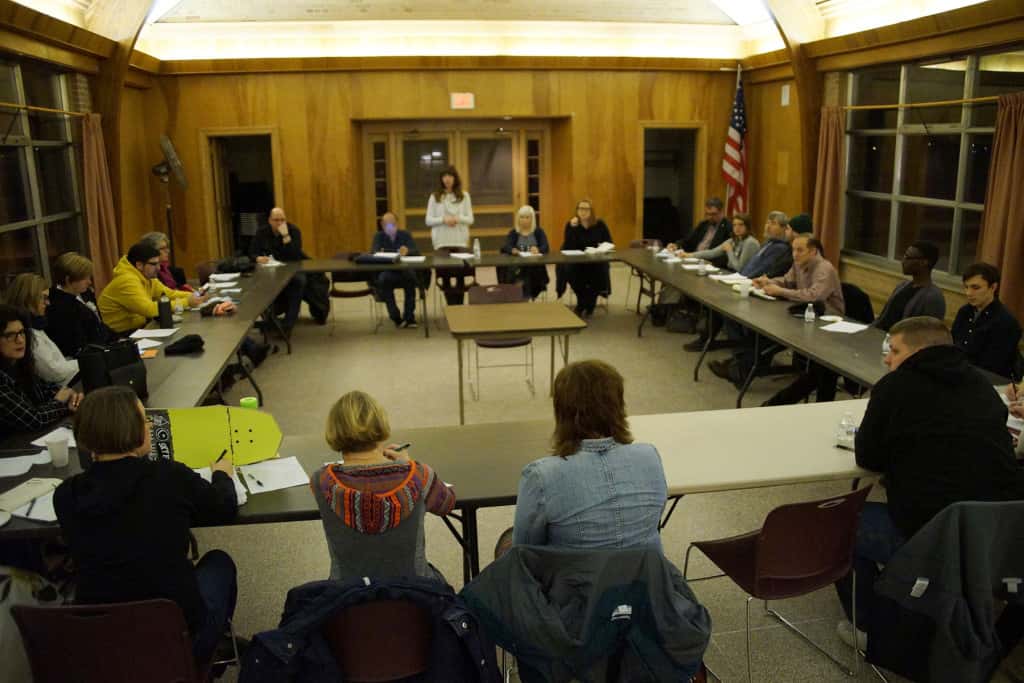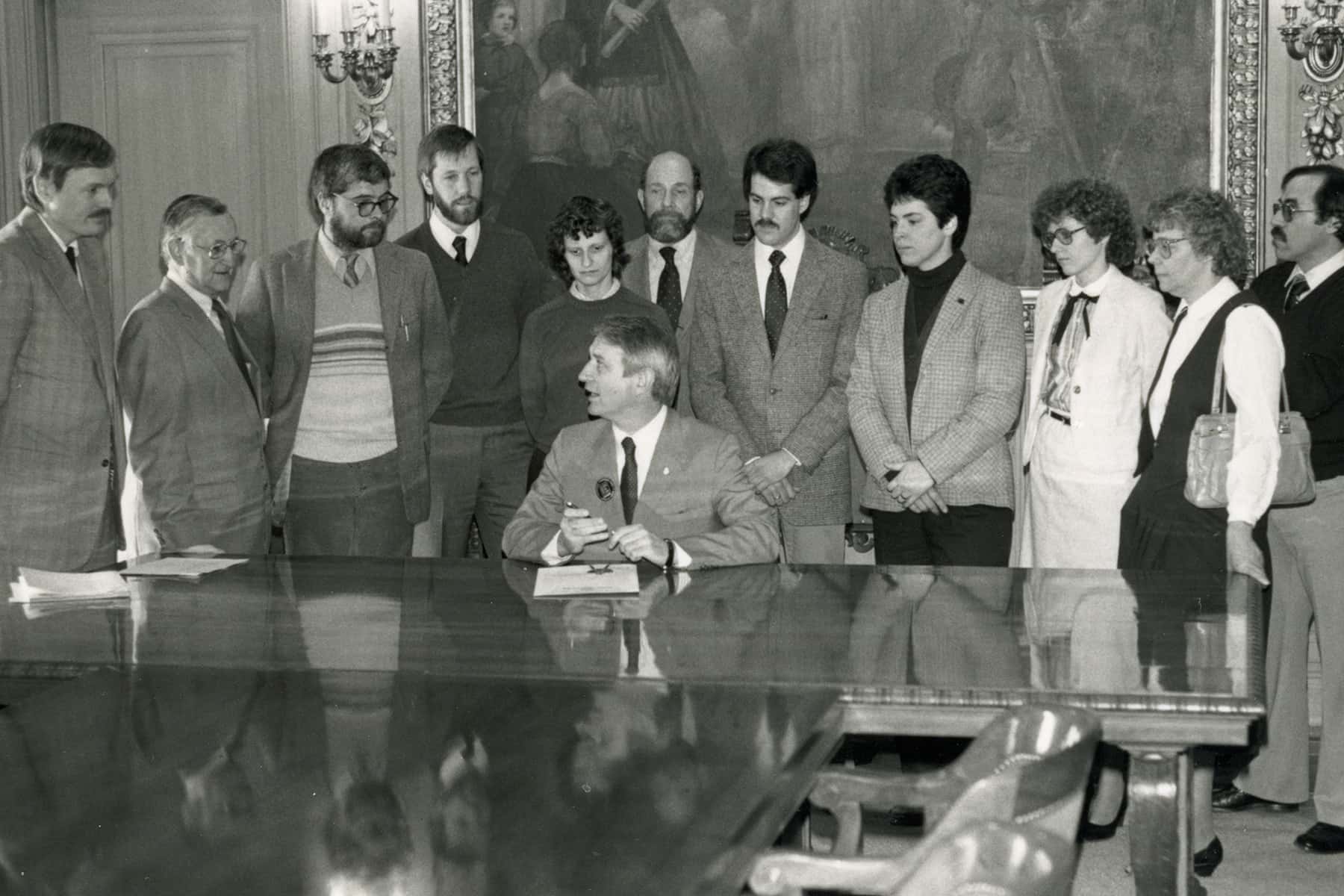
In the early 1980s, a new mysterious malady captured the attention of public health professionals. Initially labeled GRID, which stood for Gay-Related Immune Deficiency, these clusters of illnesses seemed to largely be an issue only on the East and West coasts. But Wisconsin’s government was taking action, laying the groundwork for a public health response for what would come to be known as AIDS.
R. Richard Wagner served as the first out gay Dane County Board commissioner and was co-chair of the Council on Gay and Lesbian Issues, convened in 1983 by Gov. Tony Earl, a Democrat. The group played a vital role in coordinating Wisconsin actions as the AIDS crisis emerged, and after a largely ceremonial first meeting got down to business.
“That second governor’s council meeting was in June of ’83, where we were already trying to get on top of the issue here at the state level,” recalled Wagner. “You did not have a national AIDS task force under the Reagan administration. I mean, it took Reagan a long time to even speak about AIDS.”
President Ronald Reagan did not discuss AIDS publicly until September 1985 and only at that time in response to a reporter’s question about funding for medical research. Critics cite his administration’s slow response to the crisis as a factor in the spread of HIV and public misunderstanding of the disease.
Wisconsin’s response to AIDS is recounted in Wagner’s book, Coming Out, Moving Forward: Wisconsin’s Recent Gay History, the second of his two volumes on the state’s LGBTQ history.
The manuscript was finished well before COVID-19 hit Wisconsin, but Wagner sees parallels between the two pandemics. The different paths of transmission for the two viruses — with HIV being carried by non-respiratory bodily fluids and the SARS-CoV-2 coronavirus able to pass through the air — certainly make COVID-19 a wider risk to the population, though AIDS has been far more deadly. But the emergence of both diseases required reexamination of practices and behaviors that might lead to spread of the contagion. These inquiries have included consideration of new rules for spaces where people gather in close quarters like schools and prisons.
“While the state was trying to educate and encourage the medical community and others to provide compassionate reasoned care,” Wagner wrote, “it also established new AIDS policies.” Linda Reivitiz, secretary of what was then the Wisconsin Department of Health and Human Services, created a state task force in 1985. Its goal: to develop “guidelines for virtually every situation that might involve AIDS and people with AIDS.”
Reivitz acted under broad authority granted in legislation passed in 1981 in advance of the AIDS pandemic: Wisconsin Statute 252.02. Nearly four decades later when COVID-19 struck Wisconsin, the extent of this authority was argued before the state Supreme Court, which sided with plaintiffs and on May 13 ruled Gov. Tony Evers and state Department of Health Services Secretary-designee Andrea Palm exceeded it when extending the “Safer at Home” order. The Court’s decision led to an immediate opening of taverns across the state and variable rules set by local health departments to prevent the spread of the coronavirus.
Governor Tony Earl faced no such legal challenges in 1985, and the AIDS task force moved ahead unimpeded. Chaired by Dr. David Kindig of the University of Wisconsin School of Medicine and including a number of openly gay health care professionals, the group made recommendations for practices to reduce the spread of HIV based on the best understanding of the science for the time. But it was not without some controversy.
Tracing — and mitigating — a history of stigma
Contact tracing is a mainstay public health practice used in the management of COVID-19 outbreaks and many other diseases. But in the case of AIDS, finding who a stricken patient had been in proximity to, or more likely with HIV transmission, intimate with, represented a threat to gay men, the majority of whom were likely closeted in many aspects of their lives.
“Contact tracing would be a way, again, to put together lists of homosexuals. Nobody knew what those kinds of lists would be used for,” said R. Richard Wagner. “We’d seen them used in the McCarthy Lavender Scare witch hunts. So lists of homosexuals were really sort of frightening to the gay community in that period still.”
The Lavender Scare is the name given to an era in the mid 20th century when gay people were targeted in congressional investigations, and thousands lost their jobs in government. This persecution was rampant at more local levels, as well, including at the University of Wisconsin-Madison, as detailed by Wagner in his 2019 book We’ve Been Here All Along: Wisconsin’s Early Gay History.
By the 1980s, though, Wisconsin was unique among states for its sensitivity to this well-founded fear in the gay community. State Rep. David Clarenbach, a Democrat from Madison, had led the charge for many successful gay rights protections, including the nation’s first anti-discrimination law in the areas of housing and employment.
It would not be until June 15, 2020 that the U.S. Supreme Court would rule that employers must not discriminate against LGBTQ workers as a matter of national policy.
Even with Wisconsin’s protections in place, confidentiality was an essential concern in the days long before federal HIPAA regulations for medical privacy.
“When David Clarenbach proposed in the Democratic caucus that they put these strict rules about HIV confidentiality into the state budget, most of the state legislators were more than willing,” said Wagner.
“The key to controlling the HIV epidemic, the pandemic, is not unlike the control of the pandemic today: testing, testing, testing,” said Clarenbach. “You could be, in some states, fired because you were HIV positive. You could be in many states — then still a majority of states — fired because you’re gay and that there would be no legal ramifications for such an act. Confidentiality of the AIDS test at that time was to encourage people to safely [be tested] without public disclosure of their sexual orientation and making them vulnerable.”
Wagner reports that gay men in the Twin Cities were encouraged to cross the state’s border for HIV testing because similar protections didn’t exist in Minnesota. As more became understood about HIV transmission and the unlikelihood of its spread by casual contact, concern over shielding the public turned toward protection of the pandemic’s victims. This was especially a concern given AIDS patients were often already part of frequently harassed groups.
“For the gay community, we were concerned about sort of two epidemics,” recalled Wagner. “The other was homophobia and how the disease could be used as a marker for homosexuality. There were talks about quarantining people.”
This feeling was captured in a Wisconsin Public Television report from February 1986, in which a man interviewed on the streets of Madison proposes AIDS patients all be “put in one area of the country.” According to the same report, the task force’s recommendations for schools were that students with AIDS should attend if they are able. With the established privacy protections, HIV status would not require disclosure to the district. So schools were to treat any event that might pose transmission risk, such as a student bleeding from a playground fall, as though that individual could carry the virus. This high standard would then protect all students from any number of blood-borne diseases.
But Wagner found considerable effort at autonomy in setting AIDS policy by individual districts. Racine represented what the author characterizes as an “extreme case.” School board member George Petak, later a Republican state Senator, went so far as to hold that gay men should not be allowed to teach in the district.
Actions and reactions
Widespread school closings and the implementation of at-home learning have been one of the disruptive hallmarks of actions taken in the 2020 pandemic to protect the public from the much more easily transmitted COVID-19. Keeping schools closed was one of the only state public health strictures kept intact by the state Supreme Court’s decision on the “Safer at Home” extension.
Prisons and jails present especially fertile ground for disease to spread. Reducing numbers of the incarcerated population in county jails and state prisons has been one risk-reduction strategy for fighting the coronavirus. New prison arrivals are quarantined for 14 days.
As of June 25, tracking by the state Department of Corrections indicated 270 positive tests, but all but nine of those tested had recovered. Nearly 900 inmates were described as quarantined or in isolation. Isolation of HIV-infected inmates was a major issue during the early days of the AIDS crisis in Wisconsin. This was especially true after Tommy Thompson, a Republican from Elroy, succeeded Tony Earl as governor, according to Wagner.
“Governor Thompson was particularly close with the state prison guards union. And so when there were issues about harsh treatment to prisoners with AIDS, he was not very sympathetic,” Wagner said. “They would sometimes give prisoners just peanut butter and jelly sandwiches, which they could toss into the cells rather than let them out in the general population to dine and have more nutritious food.”
This practice inspired some creative forms of protests from a newly-formed Madison chapter of ACT-UP. The AIDS Coalition to Unleash Power specialized in provocative acts to garner attention for the health crisis and the lack of a sufficient government response. Then-Madisonian Dan Savage, later to become famous for his syndicated advice column and podcast, left piles of peanut butter sandwiches in Thompson’s office with his ACT-UP colleagues to protest.
COVID-19 has likewise inspired protest, though Wagner draws a clear distinction. Before the ongoing protests against police brutality that followed the killing of George Floyd by Minneapolis police, demonstrations calling for an end to restrictions imposed for public health reasons were common around the U.S., including in Madison.
“[ACT-UP] undertook what seemed at the time sort of outrageous activities, but they were doing it out of concern for others,” Wagner said. “I think of the protest against the lockdowns today, and they’re not doing it on behalf of others. They’re doing it on behalf of themselves and what they want to do, not because they’re concerned with other folks.”
The politics of health care
R. Richard Wagner and David Clarenbach agree on the most significant commonality between the AIDS and COVID-19 pandemics: the populations most likely to be adversely affected.
“Conditions that are more predominant in the African-American and Hispanic communities, not just access to health care, but assets and wealth and income and jobs all play into making the communities of color more vulnerable,” Clarenbach said.
“That was one of the revealing things about the AIDS crisis, was that the structure of health care was not very responsive to those who were on the margins,” said Wagner. “And I think that’s probably true again today and we’re just beginning to understand.”
For Clarenbach, the most striking difference between then and now is the politics. The strives he helped make for gay rights that informed Wisconsin’s AIDS response depended on a coalition of liberals like him and Republicans influenced by Wisconsin’s Progressive tradition.
“It was a different day and age when I was in the Legislature. The politicization of every issue and the partisan divides just did not exist as they do today. That’s just tragic. And it’s being played out in the state’s response to COVID-19,” Clarenbach said.
For Wagner, the greatest difference between the responses to AIDS and COVID-19 is in the resources brought to bear to fight a pandemic.
“Having gone through the first pandemic in my life with AIDS and attended way too many funerals,” Wagner recalled, “it was like, OK. I remember when we were doing this and we were doing it on nickels and dimes. And now everybody’s throwing billions and trillions of dollars to solve something. Nobody was doing that with the AIDS crisis.”
Despite this, Wisconsin would outperform most states in preventing AIDS deaths. It’s a success that Wagner credits to the “Gay Rights State” responding to the crisis with compassion and a “medically rational Midwestern” approach rather than indifference.
Andy Soth
R. Richard Wagner
Originally published on WisContext.org, which produced the article in a partnership between Wisconsin Public Radio, Wisconsin Public Television and Cooperative Extension.

